As an Amazon Associate, I earn from qualifying purchases.
An easy step-by-step tutorial on Canning Peaches. This recipe for how to preserve peaches is perfect for beginners and experienced canners alike. Instructions include low-sugar and no-sugar options.

Peaches are one of the easiest fruits to can. Sure, you have to peel them, but that can be accomplished fairly easily.
Even better, I’m going to teach you how to make canned peaches in light syrup, so you can actually taste the fruit and not just sugar. Need no-added-sugar options? We’ve got those too!
And if you decided that peach preservation is just not for you, check out our peach freezer jam, peach butter, and our tutorial on how to freeze peaches. All use delicious fresh peaches without canning.
How to Can Peaches
*I’ll walk you through it here with some photos and tips, and you’ll also find a printable recipe card at the bottom of the post with exact measurements, etc. You can also click “jump to recipe” to skip down.
CANNING PREP
Prepare your water bath canner by filling it with water. You need to have enough water to cover the jars by 1 inch once the water is boiling.
Set the canner on the stove. Turn the burner to high. Once it reaches a boil, reduce it to a simmer. You want to keep the water hot so that everything is ready when the fruit is.
Wash and clean your jars. You’ll want to keep them warm to avoid having them crack when placed in the canner. You can fill them with hot water, or place them on a tray in the oven at 170˚F.
Wash your lids and set them aside in a clean place. You no longer need to simmer lids in water to keep them sterile. Woot!
Wash your fruit. I just run them under water and rub my hands on them to give the outside a scrub. Use a paring knife and cut the peach around the middle to separate it.

Remove the pit
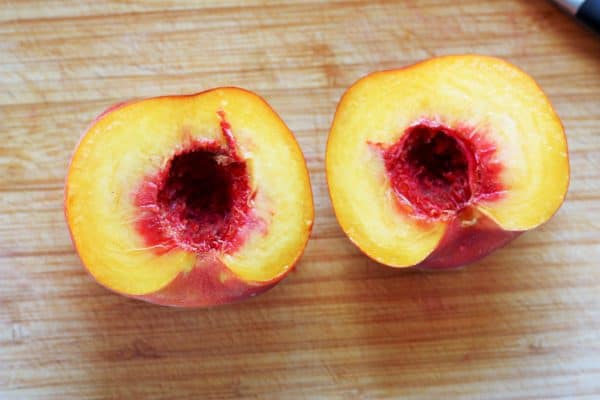
Put the halves in a large bowl of water treated with lemon juice or citric acid.
Blanching Peaches
Add one layer of peaches at a time to a pot of boiling water for about 60 seconds. Once you can see the skin starting to come away from the flesh, it’s time to take them out.
Remove using a slotted spoon and place in an ice bath for 1 minute.
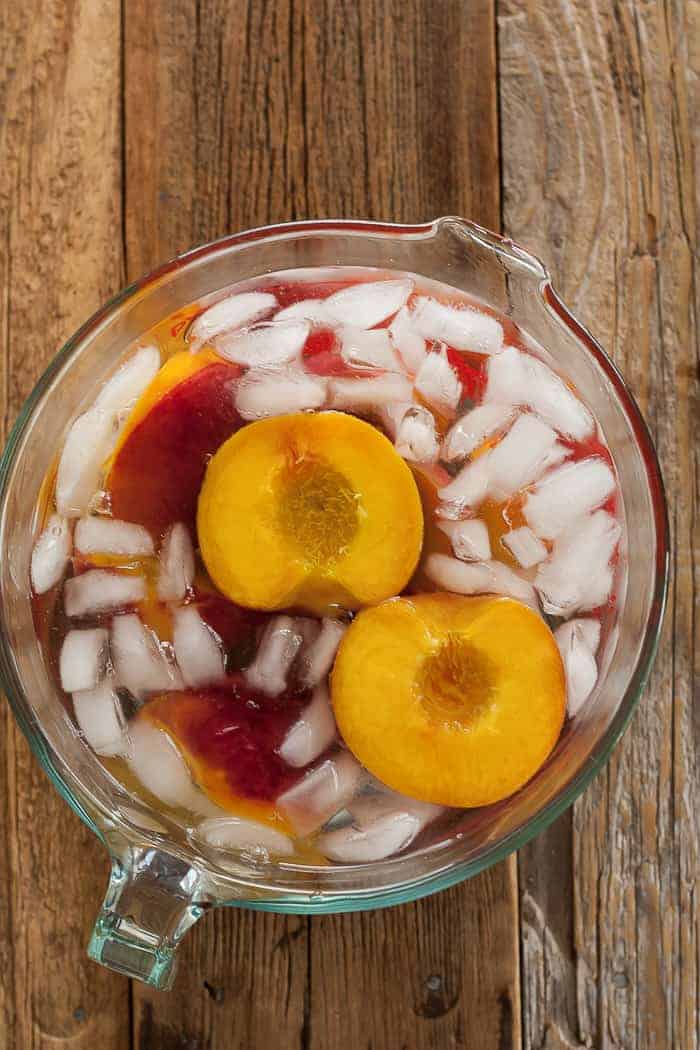
Use the slotted spoon to remove the peaches from the ice bath. Grab one and gently peel the skin back.
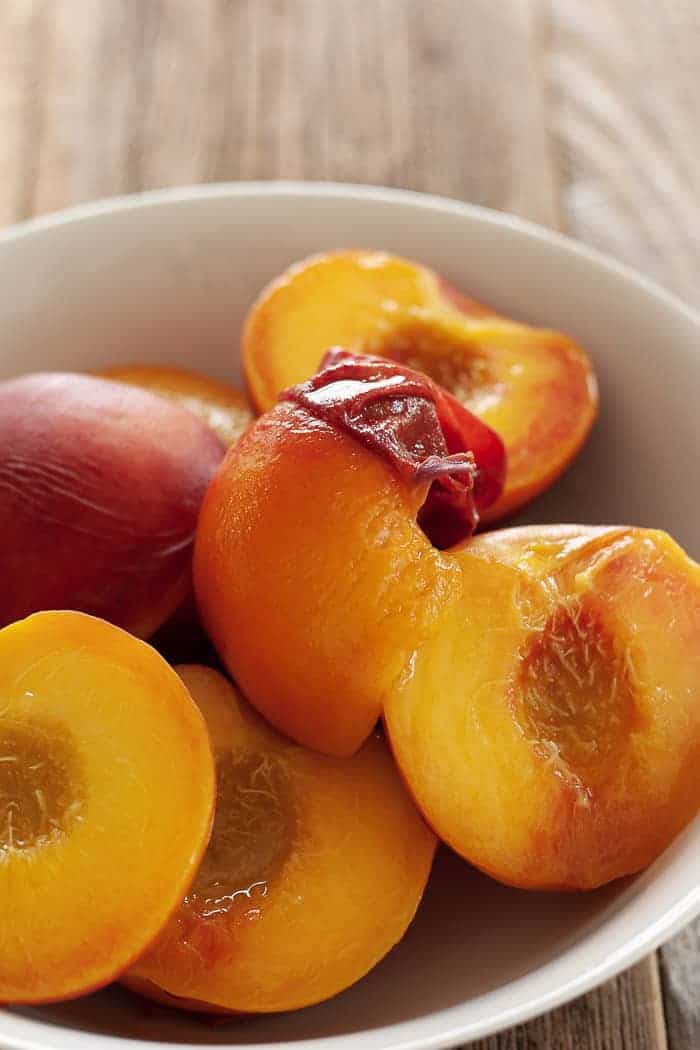
Syrups for Canning Peaches
If you prefer a no-sugar option, peaches can be canned using only water. But if you plan to can your peaches with sweetener, you can use sugar, honey, or fruit juice (apple or white grape). You’ll also want to decide how sweet you want the syrup to be.
In a medium-sized pot, combine your sugar/honey/or juice, and water to create the syrup. See the cheatsheet below as a guideline for making syrup:
Syrups for Canning
| Syrups for Canning | ||||
| Type of Syrup | Sweetener | Amount of Sweetener | Water | Yield |
| Very light | Sugar | 1 cup | 6 cups | 5 3/4 cups |
| Light | Sugar | 2 1/4 cups | 5 1/4 cups | 6 1/2 cups |
| Medium | Sugar | 3 1/4 cups | 5 cups | 7 cups |
| Heavy | Sugar | 4 cups | 5 cups | 7 cups |
| Honey | Honey | 1 cup | 4 cups | 4 1/4 cups |
| Juice | Apple or white juice concentrate | 1 1/2 cups | 4 1/2 cups | 6 cups |
| *Source: National Center For Home Food Preservation | ||||
Pro tip: if you plan to process multiple batches of peaches in a day, make the syrup and transfer it to a slower cooker set to “high”. This will keep the syrup hot while freeing up space on your stove.
Raw Pack For Canning Peaches
Raw packing simply means placing the peeled peaches in the jars without pre-cooking them, filling the jars with hot syrup, and processing them in the canner.
If you are canning your peaches without additional added sugar (sugar, honey, fruit juice), you must hot pack the fruit.
Raw packing is much faster than then a hot packing process, but there are some drawbacks. No matter how well you pack the jars, the density of the fruit will change during their time in the canner.
This often leads to something called “fruit float” in which the peaches will float to the top of the jar, leaving all syrup on the bottom. There is nothing wrong with fruit float as long as your jars are still sealed.
You’ll find this when you’re canning pears, canning apricots, and canning whole tomatoes as well.
To raw pack the peaches, add the fruit cavity-side down (where the pit was) to your sanitized and warm canning jars. This is easiest done with a fork. Repeat with other peach halves until you have filled the jar. Then, ladle hot syrup over the top of the peaches. Pro tip: depending on the size of the fruit, each quart will fit about 3-3.5 peaches.
Hot Pack For Canning Peaches
Hot packing involves cooking the peaches briefly in hot syrup before packing the peaches into jars for canning.
You’ll want to boil the peach halves in the canning syrup for about 2 minutes and then add them to your jars, ladling more hot syrup over the top.
The appeal of hot packing are that you typically can fit more fruit per jar, and the near elimination of fruit float.
Canning The Peaches
At this point, return your water in the canner back to a rolling boil.
Using a canning funnel, ladle hot syrup into the jars, leaving 1/2 inch headspace. You may need to use a spoon to gently smoosh down the fruit a bit.
Using a long utensil (I prefer a plastic chopstick), remove all the air bubbles from the jar. Clean the rim of the jar very well with a hot damp rag. Place a clean lid on the jar. Add a ring, and tighten to fingertip tight.
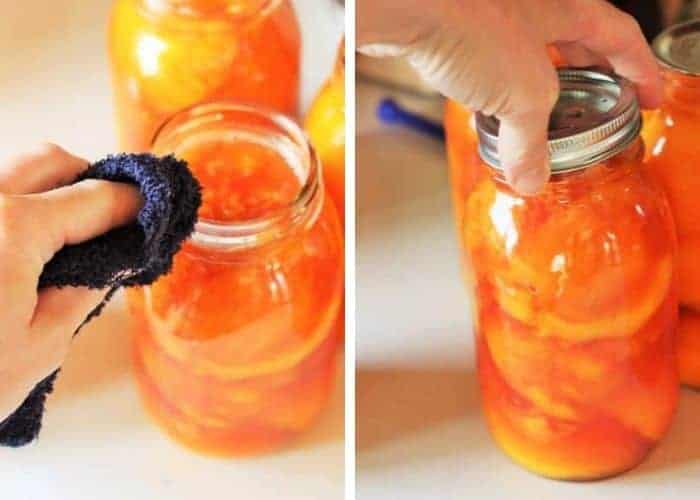
Using canning tongs, carefully place your jars in the canner. Put the lid on. Processing times will vary based on altitude. See the chart below.
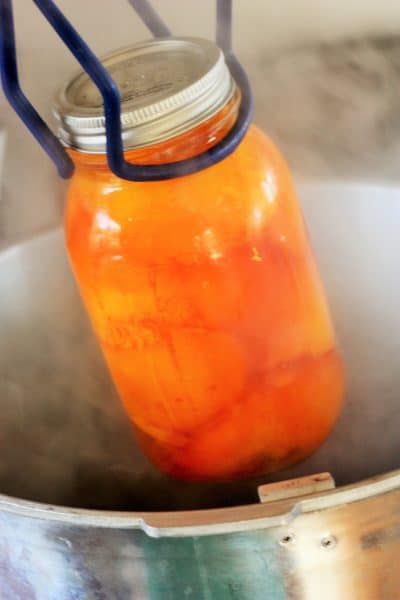
PROCESSING TIME FOR Canning Peaches
Pro tip: the water must return to a boil in the canner before you can start the timer.
Processing Time for Peaches
| Processing Time for Peaches | |||||
| Process Times at Altitudes of: | |||||
| Style of Pack | Jar Size | 0-1,000 ft | 1,001-3,000 ft | 3,001-6,000 ft | Aove 6,000 ft |
| Hot | Pints | 20 min | 25 min | 30 min | 35 min |
| Quarts | 25 min | 30 min | 35 min | 40 min | |
| Raw | Pints | 25 min | 30 min | 35 min | 40 min |
| Quarts | 30 min | 35 min | 40 min | 45 min | |
| *Source: National Center For Home Food Preservation | |||||
Once the jars have been processed for the appropriate amount of time, remove the canner from the burner, wearing oven mitts carefully take off the lid of the canner, and allow it to sit for 5 minutes. Pro tip: I tend to just slide the canner into the middle of my stove, as it weighs a ton.
Carefully remove the jars with canning tongs, and place them on a thick towel in a place where they can be undisturbed for 12 hours.
The lids will likely start to pop within 20-30 minutes of being removed from the water. That popping sound is music to your ears, as it tells you that everything has been sealed. It’s a reward for all your work!
After the jars have rested for about 12 hours, press down in the middle of each lid. If it “gives” at all, the jar didn’t seal. Either enjoy it that day, put it in the fridge, or reprocess it.
Pressure Canning Peaches
If you prefer to pressure can your peaches, follow the prep and packing process above and the canning process below.
Add 3 quarts of water to your pressure canner and put it on a burner set to high. Make sure there is a canning rack in the bottom of the canner.
Using canning tongs, gently place the jars in the canner. Lock the lid. Soon, steam will start coming through the vent pipe (I call it the steam chimney).
Allow the steam to pass through for about 10 minutes. Then put the pressure regulator (I call it the chimney cap) on top. (see the 4 photo grid below for a visual of this process step by step)
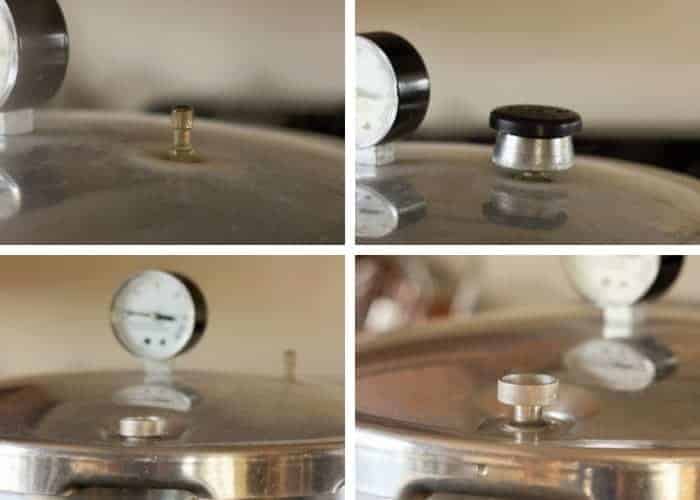
Pretty soon, the air vent will pop up. That is a sign that you’re starting to build pressure inside the canner (get excited. This is happening!). Processing times will vary based on altitude. See the charts below.
Pressure Canning Peaches in a Dial-Gauge Pressure Canner
| Canner Pressure (PSI) at Altitudes of | ||||||
| Style of Pack | Jar Size | Processing Time | 0-2,000 ft | 2,001-4,000 ft | 4,001-6,000 ft | 6,001-8,000 ft |
| Hot or Raw | Pints or Quarts | 10 min | 6 lbs | 7 lbs | 8 lbs | 9 lbs |
| *Source: National Center For Home Food Preservation | ||||||
Processing Time for Peaches in a Weighted-Gauge Pressure Canner
| Canner Pressure (PSI) at Altitudes of: | ||||
| Style of Pack | Jar Size | Processing Time | 0-1,000 ft | Above 1,001 ft |
| Hot or Raw | Pints or Quarts | 10 min | 5 lb | 10 lb |
| *Source: National Center For Home Food Preservation | ||||
When the dial gauge reaches the appropriate PSI, reduce the burner temp to medium, and start your timer. The pressure must stay at the PSA or (a little bit) above for the duration of the cooking time. You’ll likely need to adjust the temp on the burner a few times depending on your stove.
When the time is up, remove the canner from the burner and allow it to sit until you hear a distinctive “click” of the air vent dropping. Remove the pressure regulator and carefully remove the lid of the canner (Pro tip: I always use oven mitts when I take the lid off because the steam is super hot).
Let the jars sit for 5 minutes in the canner with the canner lid off and then lift them out with canning tongs. Pro tip: allowing the jars to sit in the canner with the canner lid off can help reduce the siphoning of liquid in your jars.
Place hot jars on a towel where they can sit undisturbed for 12 hours.
After a few hours, to check for sealing, gently press down in the middle of the lid. If the lid has no give, it’s sealed. If you can press the lid in and it pops a bit, your jars are not sealed.
STORAGE FOR HOME CANNED Peaches
Once the jars have sealed, remove the rings. Label and store sealed jars in a cool (best results are 50-70˚F) dark place for up to 12-18 months.
If you have the space available, do not stack the jars on top of each other more than two jars high.
Help! Why Are My Jars Leaking Juice?
If you find that juice has leaked out after they have sealed, you have experienced a common canning issue called siphoning. It happens to the best of us!
Siphoning is typically caused by not allowing the jars to rest in the canner after they have finished processing. In the directions above, you’ll see that I recommend you remove the canner from the burner, remove the lid, and let it sit for 5 minutes.
This is important as it allows the jars time to rest before being allowed to cool on the counter. Doing this process will significantly cut down on siphoning.
If you have siphoning in your jars, follow these steps:
- Check – are the lids still sealed?
- Look – have you lost less than half of the amount of liquid in the jar?
- Examine – does the fruit look fresh with bright colors?
If the answer to the above three steps is “yes!”, then they are safe to eat. If you lost quite a bit of syrup, the uncovered fruit will turn color more quickly. Plan to eat those jars first.
What if my jars don’t seal?
If you’ve correctly processed your fruit, and the lids still didn’t seal, you can reprocess them.
Double-check to make sure there are no:
- Chips in the rim of the jar
- Dried syrup or bits of peach on the rim (anything between the rim and the lid may prevent a seal.
Best practices would involve using brand-new lids for reprocessing. Set aside the old lids to use for dry storage.
If the jars don’t seal on the second attempt, you likely have a bad batch of lids, or your canning process has a step missing. Email me and we’ll try to troubleshoot what is going on.
For unsealed jars, you can place them in the fridge. Eat the fruit within three weeks.
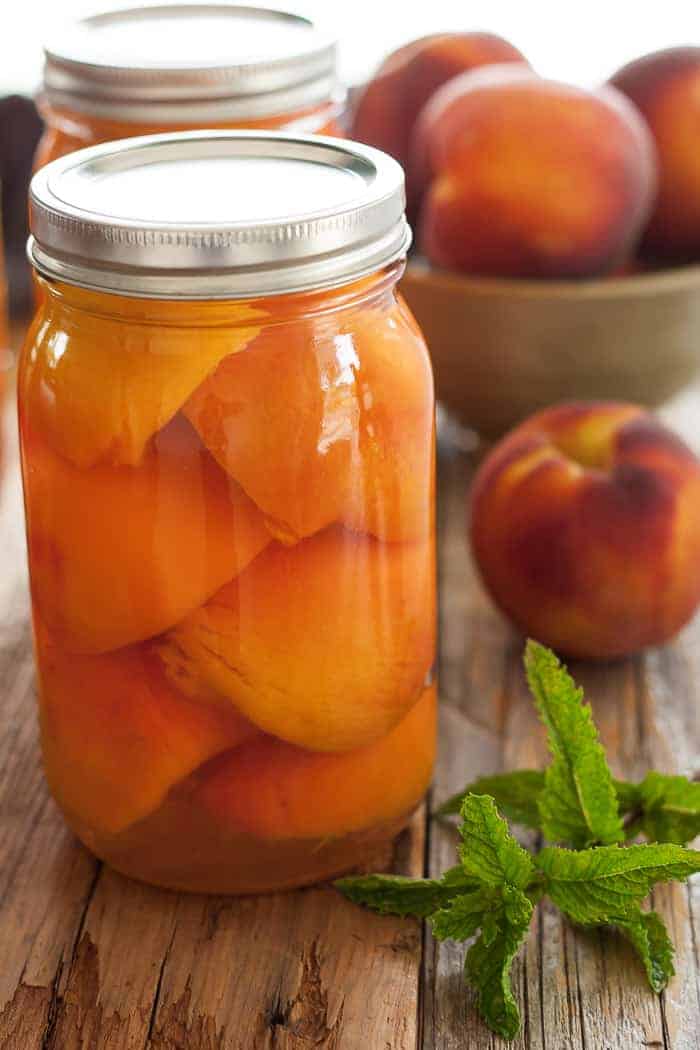
Can I make canned peach slices?
Yes! If you’d prefer to cut your fruit into slices, that is absolutely fine. Think about how you plan to use them after canning. Do you want to eat them as is? If so, halved peaches will be the easiest and fastest way to can them.
Pro tip: with canning peach slices, you’ll need to put a bit more effort into removing bubbles from the jars. There will be more opportunities for “pockets” to occur in the jars, and those bubbles need to be removed for safety.
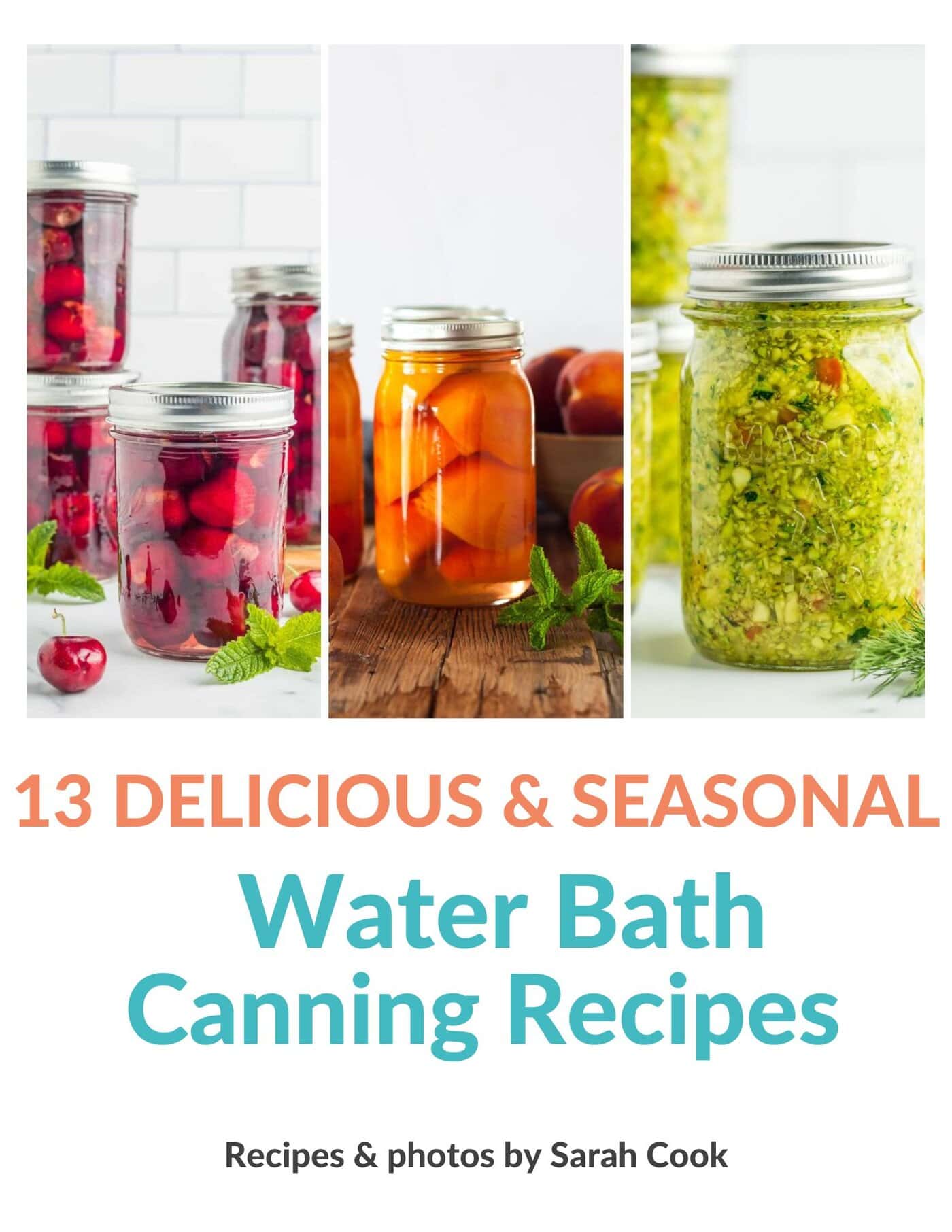
Get my Canning e-book!
It’s 51 pages of every helpful tip and trick you could want as a brand new canner, AND it includes 13 ad-free canning recipes that are designed to take you from novice to pro.
Canning Peaches (Whole, Halves, or Slices)

Equipment
Ingredients
- 17 lbs peaches
- 1/4 cup lemon juice
- 6 cups water {+more for the canner}
- 1 1/2 cups sugar
- ice
Instructions
Canning Prep
- Prepare your water bath canner by filling it with water. You just need to have enough water to cover the jars by 1 inch once the water is boiling.
- Set the canner on the stove. Turn the burner to high. Once it reaches a boil, reduce it to simmer. You want to keep the water hot so that everything is ready when the peaches are.
- Wash and sanitize your jars. You’ll want to keep them warm to avoid having them crack when placed in the canner. You can fill them with hot water, or place them on a tray in the oven at 170˚F.
- Wash your lids and set aside in clean place.
- Use a paring knife and cut the peach around the middle to separate. Remove the pit. Put the halves in a large bowl of water treated with lemon juice (~1/4 cup) or citric acid (1 tbsp).17 lbs peaches, 1/4 cup lemon juice
Blanching Peaches
- Fill a large mixing bowl with ice water. Set aside.ice
- Add one layer of peaches at a time to a pot of boiling water for about 60 seconds.
- Remove using a slotted spoon and place in the ice water for 1 minute.
- Use the slotted spoon to remove the peach halves from the ice bath. Grab one of the peaches and gently peel the skin back.
Canning Peaches
- Combine water and sugar in a medium saucepan. Bring to a low boil and fully dissolve the sugar. See the chart in the post above for different levels of syrup.6 cups water, 1 1/2 cups sugar
- (Hot Pack Method) Once the syrup is boiling, add the peach halves one layer at a time (a canning term that means don’t totally fill the pot) and heat for 2 minutes.
- (Hot pack option) Using a fork and canning funnel, grab the now softened peaches, add the peach halves, one at a time, and put them cavity-side (where the pit was) down in the canning jar.
- (Hot pack option) Repeat with other peach halves until you have filled the jar. Pro tip: depending on the size of the peaches, each quart will fit about 3-3.5 peaches.
- (Hot pack option) Using a canning funnel, carefully ladle hot syrup into the jars, leaving 1/2 inch of headspace.
- (Raw pack option) Using a fork and canning funnel, place peaches cavity-side down in the canning jar.
- (Raw Pack Option) Using a canning funnel and a ladle, fill each jar with hot syrup or water, leaving 1/2 inch of headspace. Headspace is the distance between the top of the food and the top of the jar.
- At this point, return your water in the canner back to a rolling boil.
- Using a long utensil (I prefer a plastic chopstick), remove all the air bubbles from the jar.
- Clean the rim of the jar very well with a hot damp rag.
- Place a clean lid on the jar. Add a ring, and tighten to fingertip tight.
- Using canning tongs, gently place your jars in the canner. Put the lid on, and set your timer. Pro tip: the water must return to a boil in the canner before you can start the timer.
- Process HOT PACK pints and quarts based on the elevation guide below:*0-1,000 ft – Pints =20 min Quarts =25 min*1,001-3,000 ft – Pints =25 min Quarts =30 min*3,001-6,000 ft – Pints =30 min Quarts =35 min*6,000 ft+ – Pints =35 min Quarts =40 min
- Process RAW PACK pints and quarts based on the elevation guide below:*0-1,000 ft – Pints =25 min Quarts =30 min*1,001-3,000 ft – Pints =30 min Quarts =35 min*3,001-6,000 ft – Pints =35 min Quarts =40 min6,000 ft+ – Pints =40 min Quarts =45 min
- Once the peaches have processed for the appropriate amount of time, remove the canner from the burner, and carefully remove the lid of the canner (Pro tip: use oven mitts to take the lid off because the steam is super hot).
- Using canning tongs, carefully remove the jars, and place them on a thick towel in a place where they can be undisturbed for 12 hours.
- After the jars have rested for about 12 hours, press down in the middle of each lid. If it "gives" at all, the jar didn't seal. Either enjoy it that day, put it in the fridge, or reprocess it.
Notes
- If you’re planning to can multiple batches of peaches all at once, I use my crockpot to create and keep the syrup hot. It frees up space on the stove.
- Once the jars have sealed, remove the rings. Label and store sealed jars in a cool (best results are 50-70˚F) dark place for up to 12-18 months.
Nutrition
Nutrition information is automatically calculated, so should only be used as an approximation.
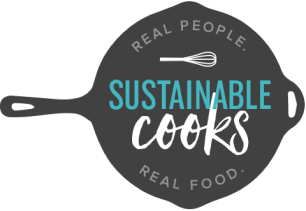

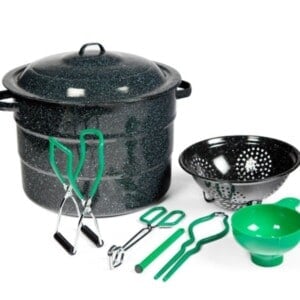
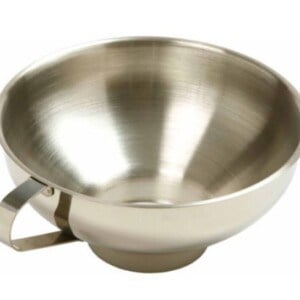
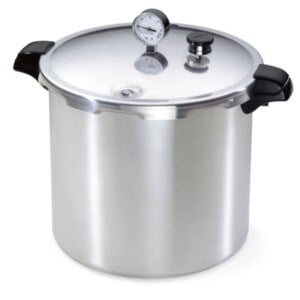
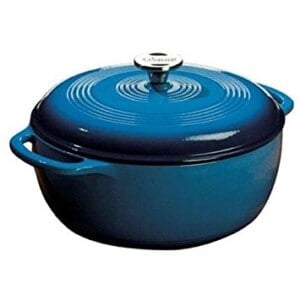
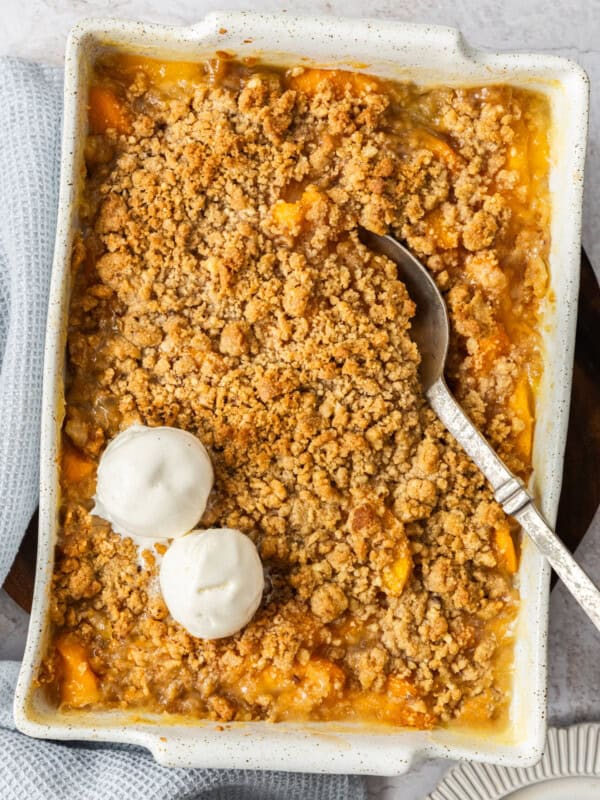
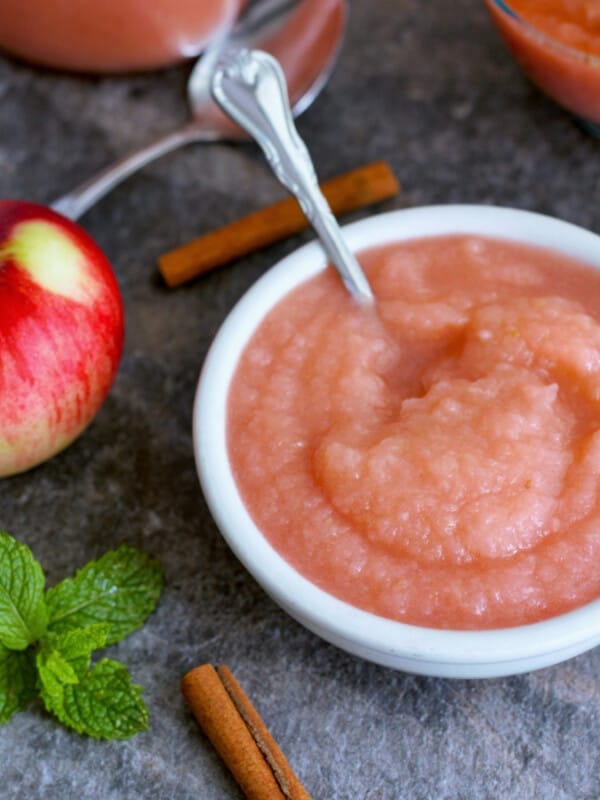

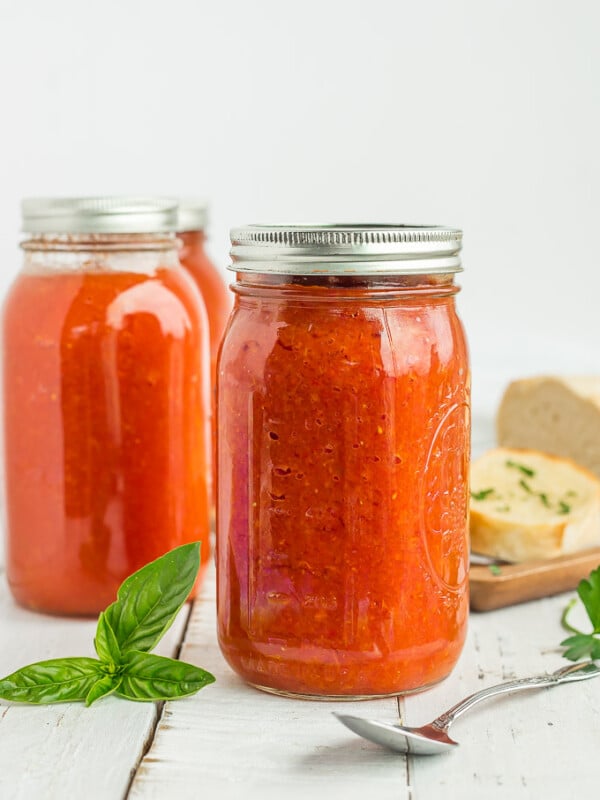
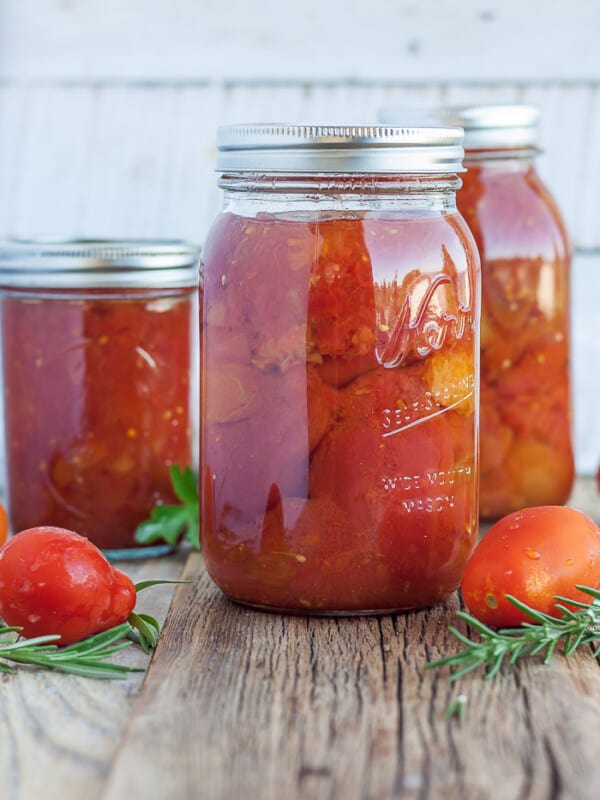
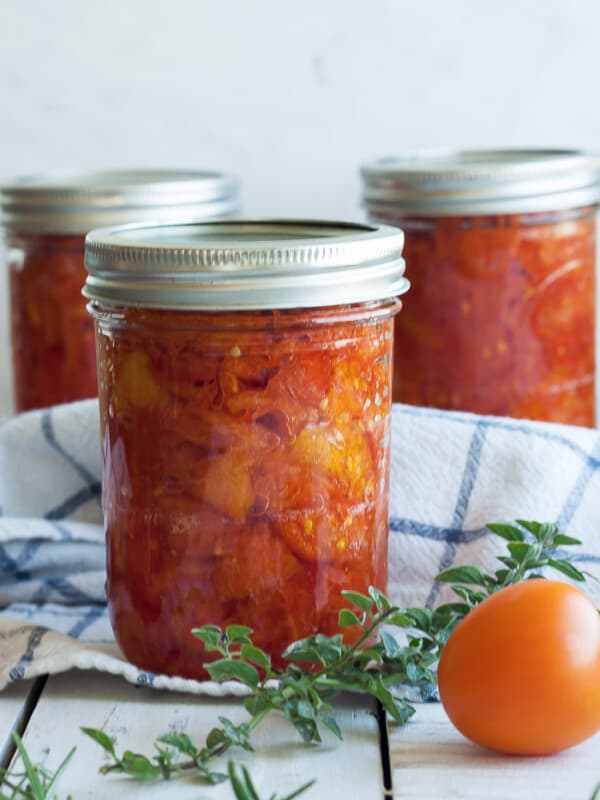






I have read your directions but am confused about hot pack as oppose to cold pack for canning peaches. Do you still need to put them in the water bath? I had a bad experience with the water bath in the past and haven’t attempted canning peaches again. I get the difference in how much more fruit you get in a jar but wanted to find out if I still need to do the hot water bath. The last time I did them I experience allot of siphoning and haven’t made them again. Thanks so much!
Raw vs hot pack only applies to what happens BEFORE you can them. The processing procedure remains the exact same regardless of raw vs hot pack. But the processing time is 5 min longer for raw pack.
Typically you experience siphoning if you take them out of the canner too quickly after they are done processing. Best practices are to take the lid off (after the time is up), wait 5 minutes and then remove the jars.
Can the peaches be stored in the refrigerator? My house is too hot to store anything. Thank you.
Do you mean once they are canned? If you need to store in the fridge after canned, it *probably* wouldn’t be worth canning them at all. I’d just peel and heat them in the syrup and then fill jars with syrup, put lids on and store in the fridge without canning.
In your tip you said you make your syrup in a crock pot. If I am using hot processing to do a lighter amount of syrup, could I hot process the peaches in the crockpot, then transfer them and the syrup to the jar prior to the hot water bath?
Brandon, the slow cooker cooks things gently over time so I don’t think it will heat the peaches quickly enough to matter in this case. And I fear if you plop them in there and let them sit too long (to get fully heated), they will be mush after processing.
If you try it, please let me know how it turns out!
Ahhhh, siphoning. Always a first, have water canned for years & never had this problem. Husband brought in fresh peaches from GA & I stayed up all nite to process them. They all sealed but I did not like the no name lids & rims that were all that was left here in rural TX. Bubbles galore!! Must have done multiple things wrong. Should I just take them all out & freeze them? Really disappointed????
I have heard horror stories about the lids that are out there right now. Even Ball seems to be having quality control issues at the moment.
As long as they’re still sealed, I would keep them. 🙂
I canned 6 quarts, first time ever. Hot water bath process. Air bubbles. Ugh! When I took them out of the bath, the bubbles I had missed during packing were moving to the top. They all sealed within a couple hours, but when I looked at them this morning I had lost a couple inches in pack volume and there’s tiny bubbles in a couple of them (almost foam like). What did I do wrong? Are they safe? Processed 40 min at 3-6000 ft. Rested in bath for 15 min. Going at it again with the other 6 quarts tonight. TIA
Hi Bonnie, it sounds you left them in the canner too long once they were done processing. Best practice is 5 minutes and then out of the water.
The good news is that they’re totally safe! The loss of liquid is called siphoning and it does happen when things are processed too long or taken out of the canner too quickly. It’s hard to find that sweet spot, especially when you are new to this.
Those bubbles are from over-processing. They won’t make the food spoil. If the peaches are still covered in syrup AND the lids are sealed, you’re totally fine. If the top peach half is not covered in syrup AND the lids are sealed, you’re still totally fine. BUT that top peach will brown more quickly so just plan to eat those jars first.
Canning at first is REALLY hard. You’re doing a great job and I promise it will get easier and you’ll feel more confident as you go!
I have peaches that are firm/hard. Should I wait until they ripen more?
Hi Jackie, yes, you’ll want to wait until they ripen more. Canning them won’t make them soft enough to actually taste good. Plus they’re much harder to peel when firm!
I processed 5 qts of canned peaches in a water bath. Three jars automatically sealed within an hour. Two did not. My husband lightly touched the two that had not “sealed” and they “popped” and appear sealed! Is that a good seal or do we need to refrigerate and use within 2-3 weeks?
I would put those in the fridge and use within 2-3 weeks. When it comes to “forced” sealing (even if by accident), I don’t play around with food safety.
Looking forward to trying this!
I have some hinged glass jars, rather than screw top- would that change the time in water bath at all?
Thanks!
Are they older-style canning jars? If so, those are no longer considered safe to use.
I haven’t seen any new hinged jars.
Hi there..I’m wondering how much water to lemon juice I use before putting the peaches in boiling water? (I’m new to this). ????
I just eyeball it. It’s probably about 1/4 cup of lemon juice to 10 ish cups of water.
So I’ve reprocessed one time because I had only 5 quarts deal and 7 not. But they didn’t pop and I’m three hours away from 24 hours on all of them.. can I put them in new containers and do the 7 again let them sit out another 12 hours and they be ok or should I put the 7 in the fridge and call it good..
I assume by deal you mean “seal”? I just want to make sure I’m answering your question correctly.
What happens when you push down on the middle of the lid? Is there any give (does it push in)? You may not always hear seals but as long as there is no give in the lid, it is sealed.
Yes sorry I had 5 seal and 7 not so I reprocessed those 7 but they did not seal so I was wondering if I could start over and try and get them to seal for a third time or just put them in the fridge and call it good..
Yes I am so sorry yes they did not seal. I had 5 seal but not the other 7. So I reprocessed those 7 and they still did not seal. So I was wondering if I started over completely and reprocessed them for the third time would that be too much or should I just put them in the fridge?
I think at this point if you processed them again they would have a pretty mushy texture when you finally ate them. I would put them in the fridge. What a bummer!
Were the lids from those 7 from a different box? Did you switch lids when you reprocessed them? It’s very odd for an entire batch to not seal. It usually points to an issue with the lids themselves, i.e., likely not something you did incorrectly.
Very useful
So glad it was helpful Melissa!
Hello I just did 12 qts of peaches in a pressure canner. I got my #s backwards, I canned at 8 min at 10# pressure at 4000 ft ele. They all sealed and look good. Are they safe to eat ? most will be in pies. Thanks in advance. I really like and use your site often. Don
Donald, I think you’re all set! 8 min at 10 psi is correct for 4000 ft elevation in a dial-gauge canner.
https://nchfp.uga.edu/how/can_02/peach_sliced.html
I’ve never heard of blanching peaches to remove the skin. We’ve always simply pared them with a knife. Have you used both methods? Does blanching them cause the peaches to be more mushy after canning than paring?
I’ve done both methods and if you’re processing a bunch of peaches, blanching them is 100% the way to go. It’s so much faster.
As long as you are parboiling them just until the skins start to lift up, and then immediately plunging them into an ice bath, there is no noticeable difference in texture.
As someone who has never tried preserving anything, this actually looks do-able. What a great tutorial! Now you’ve got me craving peaches (and singing that Peaches song from the 90’s)!
You can do it, Christine! Though someone from the UK messaged me and told me the price of canning jars over there and it was outrageous!
Hi there wondering what ratio of peaches you used for that much water and sugar? I have been looking for a recipe with a very light syrup rather than such a heavy one as is called for in so many recipes for canning peaches.
thanks!
I’ll be honest in that it varies based on the weight of the peaches, etc. For 8 quarts I probably use about 1.5 times the syrup recipe.
What peaches do you prefer to use for canning?
Anything that is labeled as “freestone”. Those are the ones where the pit pops out easily. The kind most readily available about our farmer’s market is “Elberta”.
looks pretty easy and doable!
Looks easy and doable
Interesting. I recently did a guest post (I’m not a blogger … just a canner!) on canning peaches in just WATER! This is how my Mom has always done it, and I’ve been doing it for years. If you go digging on official canning sites you can find reference to sugar not being necessary for preservation – just for color taste. I put a tiny bit of citric acid or Fruit Fresh into the bottom of each jar, raw pack my blanched/peeled peaches, top with boiling water and process. Summer. in. a. jar. 🙂
Thank you for sharing Devonna! I’ve canned in water before, and I didn’t have great results. But it definitely could have been user-error. Plus, our garage stays so warm and that is where we keep our canned goods.
Thanks for the post. There’s is nothing better than a perfectly ripe peach, is there?? My husband and I can amazing organic peaches we order from amazing WA state each year and EVERY TIME time they end up over-processed. Like, “you can’t pick them up with a fork” over-processed. The only thing I’ve come up with is that the canner takes too long to come back to a boil before I begin the timer. Tell me, while you are packing each jar, where are the other jars sitting? Mine sit in a 200-degree oven until they are all full to keep them hot. Could this be the cause of mushy peaches? I’m paranoid a jar will break in the canner (it’s only happened once) or they will lower the canner temp too much, so I keep them as hot as possible through the process.
A few questions for you. What kind of syrup are you using? Are you doing a raw pack or hot pack?
For peaches, my jars are sitting on the counter full of hot water. I use the jar in the oven method for certain types of canning, but not peaches.
I’ve tried both light syrups (one time with sugar, one time with honey) and one time plain water. All 3 were cold pack. Same results every time – sloppy peaches. I’m wondering if the peaches are too ripe when I can them?? I’m canning them at the same ripeness that I would choose to eat them, but maybe I need to can them when they are a little firmer?
Are you processing in a water bath canner or pressure canner? Are you doing 25 minutes processing time? The peaches I can are ripe enough to eat, but not so ripe that they’re hard to handle.
Yup, quarts in a water bath canner, for 25 minutes…but that doesn’t include the amount of time it takes to get the water back up to boil once I take the lid off and add my first jar. It takes me so long to get all 6 jars filled with fruit and syrup and I set each jar in the canner as I fill it…is that right? Or should I leave filled jars on the counter and put them all in the canner at once?? The directions are never clear on this step! I always worry my jars won’t be hot enough when they enter the canner, hence the use of the oven.
Ok, ding, ding, ding we have solved the problem! Yes, you need to put all the jars in at the SAME time and then start the countdown.
I fill a jar with peaches and then ladle in the hot syrup. Then I take the next hot jar (you could remove it from the oven at this point. I just dump the hot water out of it), fill it with peaches, and then put the syrup in. Continue until I have 7 quarts done. THEN I clean the rims on all of them, THEN I put the lids on all of them, THEN I do the rings for all of them. The whole time this is going on, the lid is still on the canner. I open it just one time and put the jars in. It is easier to keep the water from dropping too much temp that way.
I think if you try the above method, your peaches will stay much fresher.
Presto! So you rely on the hot syrup to keep the glass hot enough to prevent breakage. I didn’t think you could do that. I’ve only had one jar break in the canner with my method and it has me completely paranoid!! Thank you SO much for your time!!!
I do. I have a few jars break every canning season (with all various products), and I just consider it part of the deal. It happens, and you can clean the outside of the other jars and call it a day. 🙂